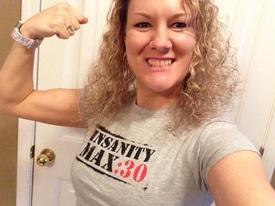Understanding BMI Print Out

sibeluver03
Posts: 58 Member
My gym has a BMI scale. I know they might not be very accurate but it's still fun to see. I don't really understand the results though. My BMI did go down, but what does all the other stuff mean? Should I be happy with these results? I started T25 Gamma on the day of the first print out and today will be my last day of the program. (Going to do another month because it's amazing.) What is my ideal BMI? I'm female, 30yo, 5'4" work out 5 days a week including some running 1-2 times a week, and I have lost over 50 pounds since my journey started. Thank you for any help!
0
Replies
-
BMI is just a function of your weight in relation to your height, and you can calculate that yourself on an ordinary calculator (divide your weight, in kilos, by the square of your height, in meter) or an online BMI calculator. Impedance I don't know what is, BMR is your "basic metabolic rate" or the amount of calories you burn per day at complete rest, fat mass may or may be way off, the other stuff seems to be "fat free mass" and "total body water" which also will be more a lucky guess than reliable and worth spending mental energy on.
A healthy BMI is 18.5 - 24.9. Your ideal BMI is the point or range where you are comfortable with both the weight and the lifestyle that maintains that weight.1 -
There are a few things there. Fat%, impedance, FFM (fat Free mass) and TBW (total body water) are all calculated by the scale's bioelectric impedance measurement mechanism, which you should be skeptical of. Your BMR is what the scale estimates you burn just existing, without factoring in exercise or what you burn just by going about your day.
Okay, so bioelectric impedance measurements aren't exactly... accurate. The way they work is to put a very minor current into one arm (or leg, or finger) and measure the resistance [aka impedance, measured in Ohms] between that and the second input. They use that resistance to estimate what percentage of your body is water and from there, using your weight, to extrapolate lean body mass vs fat (which has a higher resistance). So it's hugely affected by being well hydrated vs dehydrated, or by having recently exercised, or by your body composition, or by how recently you ate, your heart rate, or the price of tea in China.
http://digitalcommons.wku.edu/ijes/vol4/iss3/2/ <-- Accuracy of Consumer Grade Bioelectrical Impedance Analysis Devices Compared to Air Displacement Plethysmography
specifically quotesOther studies suggest that segmental BIA provides a relatively accurate estimate of percentage body fat in specific populations such as high school aged children (17, 21), male wrestlers (32) and the elderly (26). At least two studies specifically indicated that BIA measures are not valid in female populations (10, 13) as was found in the current study. It is possible that there is greater variation in the location of fat deposition in females which makes it more difficult to use a single generic formula to accurately measure %BF using segmental BIA models. That same study concluded that biolelectric impedance analysis was not really accurate enough for one-off readings and was better for watching trends in, say, a weight-loss program.
like - here is an article where they found that eating immediately before taking a %BF reading will cause it to drop precipitously - up to 10% over the course of the day - that it takes 7 hours for readings to return to baseline, and that the effect is additive. They also note that the electrolyte concentration in those meals seems to have a significant effect, that the time of day where subjects received the lowest bodyfat reading was different in men than in women, and that body positioning (ie, is the subject lying down asleep or have they been wandering around) seems to have an effect as well. (Full text of the article is here )
So the accuracy of these things depends on how active you are right now, how active you have been that day, if it's the beginning of your workout or the end, how recently you ate, what you ate, your salt intake, your gender, what time of day it is, and how hydrated you are. At a very minimum.
Also, I have some experience with medical electrophysiology (think heart monitors, or sleep studies). Before you put electrodes on a patient, you scrub the skin with alcohol pads and/or abrasive skin prep solutions in order remove dead skin cells/oils to improve electrical contact and specifically reduce impedance between the inputs. If this is a scale, your callused feet are going to up the impedance significantly.
Basically: if you have regular access to one, and you can take regular readings at the same time over a long period of time, it can be used to track trends in your bodyfat percentage, though I would take the absolute number with a heaping pile of salt. (Which... would then lower the reading).
edited to add the fulltext link which I forgot the first time0 -
Congratulations on the loss! Great progress I think those other figures are body fat percentage, body fat in pounds and lean mass in pounds (although it is notoriously hard to properly get true bodyfat figures from a scale, scanners and water displacement is far more accurate so I'd take those figures as estimates)
Your BMR estimate is basal metabolic rate those are the calories your body needs to function (heart, brain, muscles, lungs digestion) if you were in a coma some say you should try not to eat less than your BMR whilst restricting calories. Even with a desk job you should be able to eat yor BMR cals and still lose weight.
I thiiink TBW is the amount of water or fluid in your body not sure on impedance that looks like an Ohm symbol though so some sort of electrical measure?0
This discussion has been closed.
Categories
- All Categories
- 1.4M Health, Wellness and Goals
- 398.2K Introduce Yourself
- 44.7K Getting Started
- 261K Health and Weight Loss
- 176.4K Food and Nutrition
- 47.7K Recipes
- 233K Fitness and Exercise
- 462 Sleep, Mindfulness and Overall Wellness
- 6.5K Goal: Maintaining Weight
- 8.7K Goal: Gaining Weight and Body Building
- 153.5K Motivation and Support
- 8.4K Challenges
- 1.4K Debate Club
- 96.5K Chit-Chat
- 2.6K Fun and Games
- 4.7K MyFitnessPal Information
- 17 News and Announcements
- 21 MyFitnessPal Academy
- 1.5K Feature Suggestions and Ideas
- 3.2K MyFitnessPal Tech Support Questions

